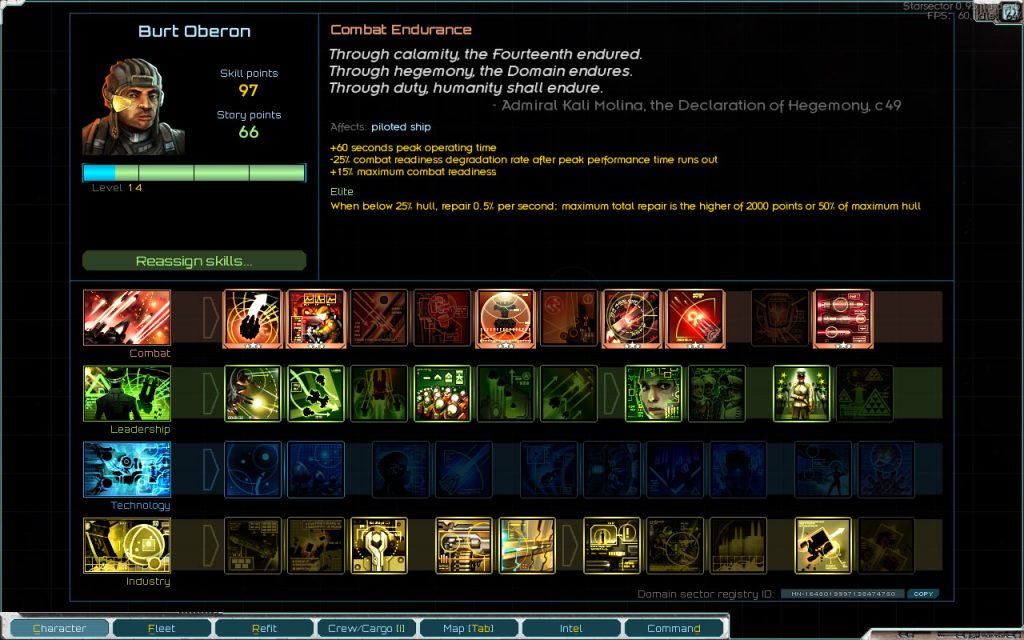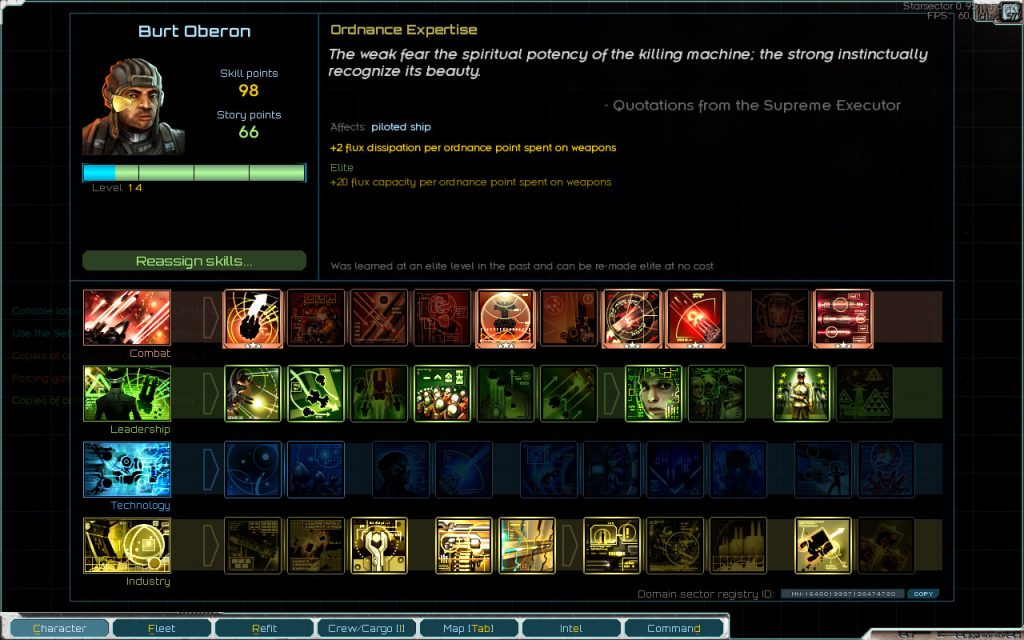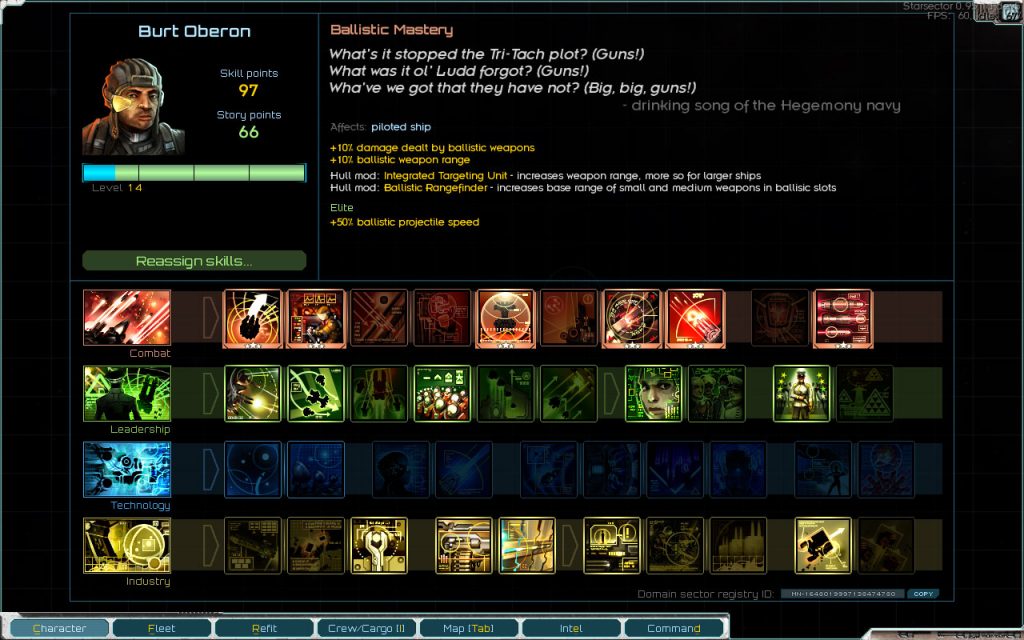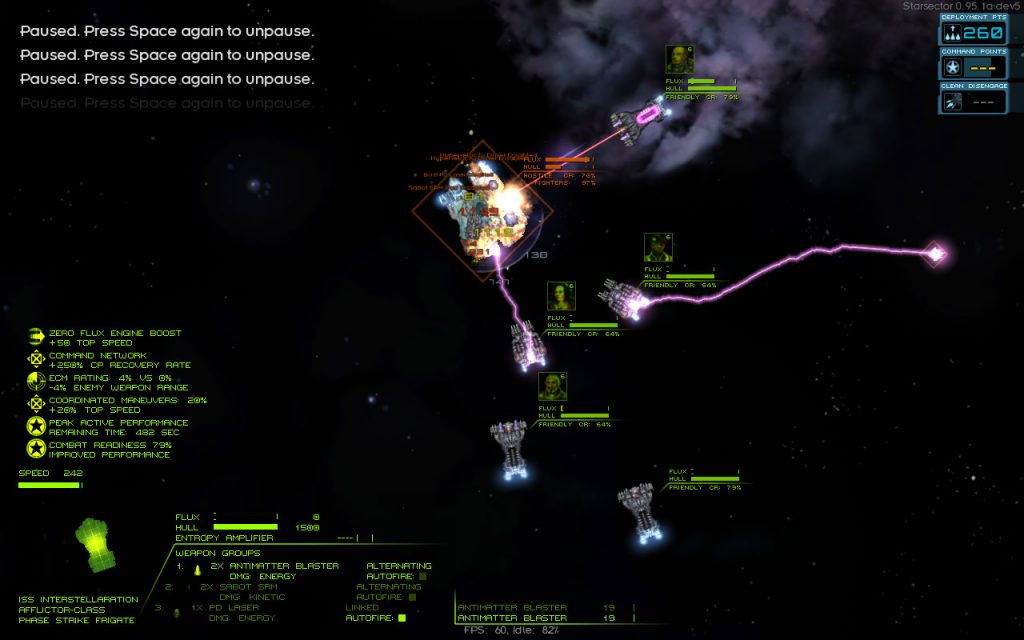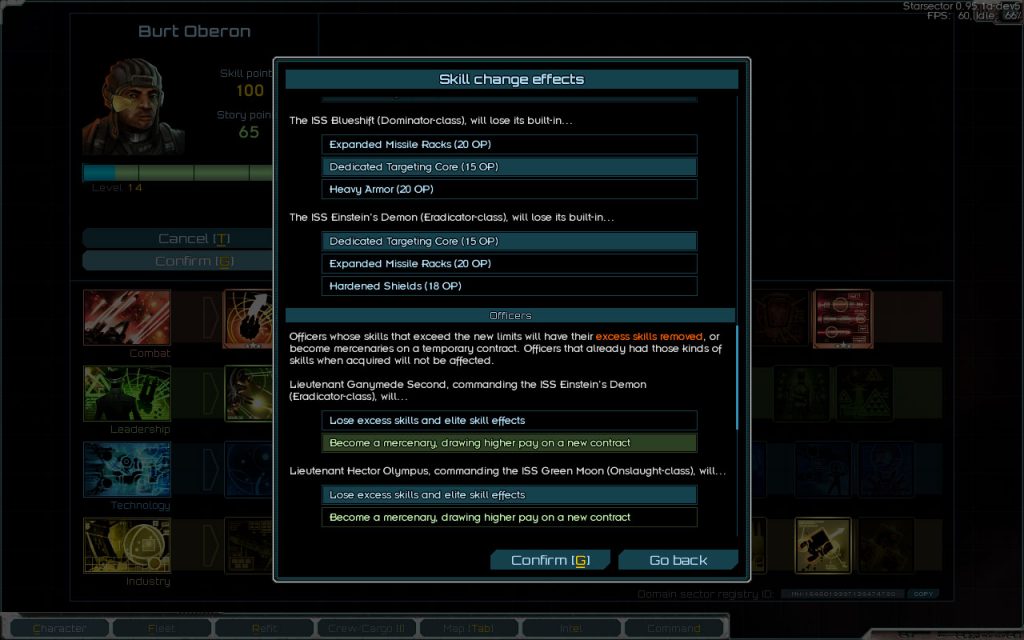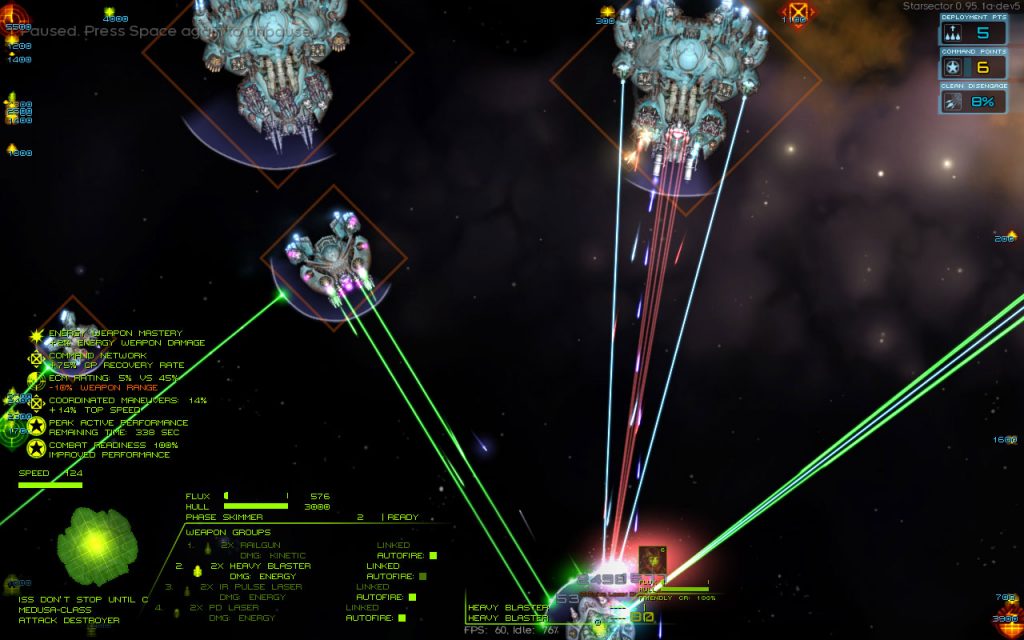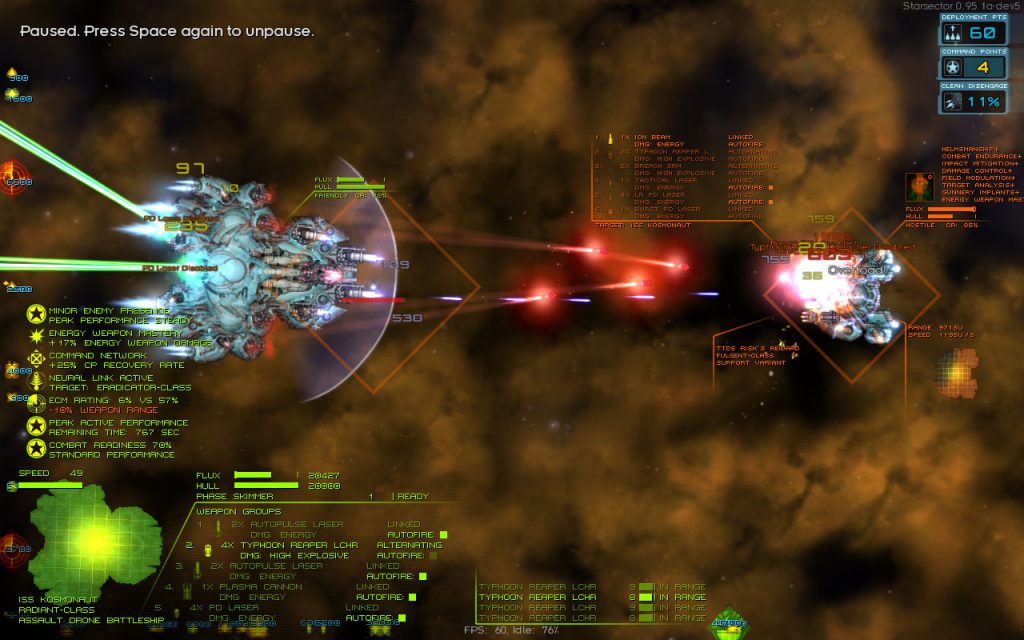Skill Changes, Part 2
Part one of this two-part blog post is here.
In this part, let’s dive into a few details about specific skills, and some other points note. I don’t want to go through every single change – just highlight some interesting tidbits, and a couple of the bigger changes.
Elite skills
One of the goals was to do a pass over the “elite” effects of the combat skills and make them more interesting/powerful/appealing. For example, Helmsmanship’s elite effect now – in addition to its original “0-flux boost at any level” effect – grants a flat +5 to top speed, making it a consideration for slower ships. Combat Endurance and Damage Control got some brand-new, fun elite effects.
Combat Endurance brings back the “repair ship hull during combat” effect from several versions ago – repairs up to 25% of the hull level, with total repairs not exceeding the higher of 50% of the hull, or, as of right now, 2000 points. With Combat Endurance being a skill that’s great for small ships, the elite effect is, too, because of the potential to repair far more than 50% of the hull over the course of a battle.
Damage Control’s elite effect grants a reduction to large hull hits – any hull hit above a certain threshold of damage has the portion above the threshold reduced by (again, as of right now) 60%. No-one plans on being hit by a Reaper torpedo, but still, neutralizing that much damage when things go wrong is going to have a lot of appeal. To make the skill not completely neutralize the strike potential of certain weapons, this effect only triggers at most once every two seconds.
Ordnance Expertise
A new personal-combat skill in Industry, this is a fun one – it boosts flux dissipation (and capacity, as an elite effect) based on the number of ordnance points spent on weapons. This favors ships with lower flux dissipation values just because it’s a flat rather than a percentage bonus, so they receive comparatively more benefit. Still very useful for ships with high flux dissipation, though!
It being a good skill for any kind of ship is important – it helps with players with different goals find a useful path up to the top Industry tier. But having a flat rather than percentage-based bonus is interesting, too – flat bonuses can be more game-changing. Just as long as they’re not too game-changing.
Polarized Armor
The other new personal combat skill in Industry, this one is a boost to armor-tanking when at high flux – increasing effective armor and reducing EMP damage taken based on the current flux level. Notably, the ship AI does most of its armor tanking when it’s at high flux, so this skill combines with the existing AI behavior nicely. The elite effect speeds up venting; this is universally good but especially useful on ships with lower base dissipation rates.
So, once again, a universally useful skill, but even more effective for certain types of ships.
Ballistic Mastery
A new skill in Combat, and a counter-part to Energy Weapon Mastery – this increases the damage and range of ballistic weapons. The elite effect increases projectile speed – I think that’s maybe a “deceptively good” bonus, since on paper it doesn’t do very much, but it can increase the hit rate, especially vs smaller/faster targets, by quite a bit. And if the bonus was phrased, as, say, reducing the weapon’s flux generation by 20%, that’d be considered amazing.
Colony skills
If you’ve read part one of this post, you might be wondering where all the colony skills went. The answer, for most of them – except for Industrial Planning – is “in the bin”. The reason for this is simple – colony skills boost passive income, and that’s… well, it’s boring. As a rule, skills should let you do new things and modify in-game actions. Even if one’s preferred style is to go for more colonies – that’s fine, and there are ways to do that! – but that doesn’t mean that you should be able to sink skill points into colony-boosting skills.
Industrial Planning gets a pass because it can do some comparatively interesting things in enabling you to use some colony-related items found during exploration, and it also boosts custom ship production. The other skills were more just “numbers go up” kinds of skills. It wasn’t the worst thing to have them, but to make room for some of the new top-tier skills? They were first on the chopping block, by a long way.
On the other hand, once colonies have a more active role in the game… right now they’re kind of a stub – a bunch of mechanics that work together but don’t have a larger point. “Making you a pile of credits” isn’t a point – rather, that’s just another question it’s asking – what are all those credits ultimately good for?
Imagine, though, if a colony with a Military Base let you dispatch a task force or two that could help you with particularly difficult fights. Skills boosting those hypothetical task forces, now that would be interesting! But until colonies settle into their real role, skills boosting them are mostly just taking up valuable space.
Where does this leave freelance administrators you can hire? They’re not actually too affected; instead of having 0, 1, or 2 skills, they just have no skills, or Industrial Planning.
Alpha Cores – which you can install as colony administrators – also get Industrial Planning. In addition, they also get a unique “Hypercognition” skill that confers some of the benefits of the previous colony skills.
Phase ship changes
Phase ships are almost a tangential topic to skills, but since some of the skills were heavily intertwined with how phase ships work, it made sense to make some changes here, too.
A brief recap – when a phase ship’s cloak is turned on (i.e. the ship is “phased”) it can’t be damaged by anything, and time on the ship passes 3x more quickly – meaning, to the external observer, it moves very quickly. Once a ship unphases, it’s vulnerable for a couple of seconds before its phase coils cool down and it can phase again.
There are two primary ways you can play a phase ship. One is more of an “assassin” build – move to a vulnerable spot, usually behind the target, and unload a lot of damage quickly. The other is more of a “brawler” – utilizing the phase cloak to both avoid damage, and using the time dilation effect to let burst weapons recharge more quickly, at least from the perspective of the target. The latter is more interesting – there’s more play there – and the former is more powerful.
The main problem with phase ships, is, well, they’re really fast thanks to the time dilation effect. It’s too difficult to pressure and punish them – once their flux is high, they can just move away and vent. You can still do quite a lot with beams and fighters, and overall the whole thing “works”, but I think it could be a lot better if they were more vulnerable.
The most obvious way to make them more vulnerable is to increase the phase cooldown duration – they’re unable to phase out for a longer period of time after attacking, thus more vulnerable, problem solved, right? Unfortunately, that doesn’t work out. This kind of vulnerability is too binary – or, perhaps, “too volatile” is a better way to put it. An extra half second of cooldown might mean a ship gets completely obliterated, or it might mean nothing at all. We need something that’s more elastic – how vulnerable it is should be on how much it overextended, and how it’s being pressured.
The most obvious candidate for this is basing the vulnerability on the ship’s hard flux level. Just basing the cooldown on it doesn’t work, though; that’s still too volatile. We need something with more wiggle room, and that’s movement speed.
Thus: a new mechanic for phase ships where their movement speed is reduced down to a third of its normal value as hard flux levels go up to 50%. Since they move 3x more quickly due to their time dilation, their relatively faster movement is cancelled out by that point. I’ve also thought about modifying the time dilation magnitude instead of adding a separate modifier to speed, but that affects “brawling”-style phase ship builds as well, and I don’t want to weaken them.
There’s an in-fiction explanation for the top speed penalty that I’m really fond of, too! Phase coils are what enables the ship to maintain its grip on this reality. (What happens if they go offline while phased? Definitely horror holovid material there!) When hard flux levels go up, this task is more difficult (say, it requires finer calibration, etc), so the grip “slips”, and much of the ship’s drive energy is wasted/not translated into movement in normal space. Sort of like running on a treadmill – you can outrun it, but it’s not exactly an optimal use of your energy.
While this change of course tones phase ships down, I think it will also make using them more engaging. There’s more to consider, and you’re particularly encouraged to not phase until absolutely necessary. Facing phase ships is more engaging, too – if you can isolate one from support, you can actually chase one down if you’re using a faster ship or just have fighters on it. And on the phase side of things, teamwork and using allied ships for cover becomes more important.
To compensate for this change a bit – and in keeping with the approach of reducing volatility – many phase ships are now tougher, with either higher armor, hull points, or both. These changes are more pronounced for smaller phase ships that were comparatively more fragile.
This is also an opportunity to spice up the possible phase ship builds! Now that there’s a mechanic holding them back a bit, there’s something to work with. To start with, there are two new hullmods for phase ships.
Adaptive Phase Coils increase the hard flux level at which speed bottoms out to 75%. This, naturally, facilitates an “assassin” type of build. Phase Anchor increases time time multiplier to 4x, but reduces the ship’s speed while phased by half – this is good for the “brawling” style.
I started this section by talking about how skills are intertwined with phase ship mechanics, so, let’s talk about those.
Phase Coil Tuning
This skill is the renamed Phase Corps (which sounded a bit too much like it belonged in Leadership). Its effect is a bit different, though – instead of reducing phase cloak cooldown, it increases the speed of phase ships, while phased, by up to 50%. This bonus goes down once you have more than a couple of phase ships (this represents the limited engineering/science talent on your staff/in your fleet, and so on). It still increases peak time.
In addition, this skill boosts the sensor strength of phase ships. You might reasonably ask, “why?” The reason is that there’s a change to how phase ships improve the overall fleet’s sensor profile – instead of applying a flat reduction, it now applies a multiplier.
The reason for this is a flat reduction was confusing. The actual range your fleet is detected at is a combination of your sensor profile and another fleet’s sensor strength. A flat reduction applies to this combined value, but for example say you have 500 profile, and a reduction of 100 – that feels like the range you’re detected at should be reduced by 20%. But once you add in another fleet’s sensor strength – which could easily be 1000 – the actual reduction is nowhere near that. On the other hand, if the reduction is a multiplier, what it does to your displayed sensor profile is representative of what happens to the actual range you’re detected at.
That still doesn’t explain the sensor strength boost from the skill, though. The reason for that is the sensor strength of phase ships, relative to the sensor profile of the larger ships in your fleet, is what determines this multiplier. Plus, having a “you can see further, too” bonus in a skill for stealthy ships feels thematic.
Field Modulation
The other skill involved here is Field Modulation. Formerly, we had “Shield Modulation” and “Phase Mastery” – now, most of their effects are combined into a single skill. A nice effect – and primary goal – of this change is so you don’t feel locked into “always flying phase ships personally” or “never flying phase ships personally” depending on whether you have the Phase Mastery skill.
Phase Mastery’s elite effect increased speed while phased by 100%. This was ok when phase ships were super fast while phased anyway – it was almost (not quite, but almost) a quality of life bonus, since a phase ship could get away from anything regardless. Now that speed is an actual balance consideration, this bonus has moved to Phase Coil Tuning, in an altered form. Instead, the elite bonus of Field Modulation reduces phase cloak cooldown by half. Since, again, there are other mechanics holding phase ships in check – and phase cooldown is not a critical issue – we can apply a more liberal bonus to it. It’ll reduce the volatility of phase ships, while not significantly affecting the ability of other ships to pressure them.
All in all, I think this leaves phase ships in a better place (though, admittedly, I need to do a bit more playtesting). With some investment, it’s still possible to get phase ships to go pretty fast. But even at a baseline level, they’re still very effective – I mean, let’s face it, they had lots of room to be toned down. More importantly, though, there are now more interactions, both in terms of the available ship loadout and skill options, and when they’re used in combat.
Reassigning skills
Another goal was making skill reassignment (you can respec your character by using a story point) smoother. This involves two main changes.
The first is simple – the game now remembers which skills you’ve made elite at any point, and speccing out of them then making them elite again doesn’t cost you an extra story point – once it’s been made elite, making it elite when speccing back into it is free.
The second is complicated. Some skills are flagged as “permanent”, meaning they can’t be specced out of. That makes sense for some skills – you’ve got a skill that lets you build more permanent hullmods into your ships, or train officers to a higher level. If you can spec out of those, you’d just take them, get the permanent benefits, and then take those skill points and spend them elsewhere.
Still, having permanent skills really puts a damper on things. The idea is to reduce decision paralysis – you can try a skill/build, and if it doesn’t work out, no big deal, you can try something else. But with permanent skills, we’re right back to where we started as far as that. Well, maybe not *quite*, since you can avoid them and still try other things out – but still, just a couple of permanent skills do a lot of damage here.
This is one of those problems where there’s no clean, elegant solution. At least, I don’t see one – besides, say, “don’t have skill effects like that”. That’s certainly clean and elegant, but – baby, bathwater, etc. So – time to get dirty and get this worked out in a way that’s, frankly, not much fun at all on the dev side of things. What we need to do is go through each troublesome skill effect and add palatable a way of undoing it.
One of the skills lets you add more flux vents and capacitors to your ships than otherwise. That one is not too bad – just remove the excess from ships in your fleet. And also when adding ships back into your fleet from storage.
Other skills let you have more officers, and let the officers be higher level/have more elite skills. This gets more complicated, because not all the officers you might have that exceed these parameters were actually trained by you – for instance, those cryopod officers we talked about earlier; they have to be excluded. Also, we have to keep track of which skills were gained last, and made elite most recently, to know what to remove. And, finally, because it’s a bit weird to just chop off officer skills/levels without asking the player, there’s a new option – when you spec out of these skills, you have the choice of whether to 1) pare the officers you have down to size (with whatever in-fiction explanation for this you feel like suppling. “It was all a dream”? Let’s hope you can do better than that.), or 2) convert the officer into a mercenary on a new contract instead, letting them keep all of their skills.
And then we have the skill that lets you build more hullmods into ships – in this iteration, Leadership’s “Best of the Best”. It defaults to removing the cheapest built-in hullmod, but for ships in your fleet you have the choice of which hullmod to remove to get within the new limit. As with officers, we’ve got to track whether the hullmods were actually built in by the player, or whether they just acquired the ship that way.
But there are complications – some ships might not be in the player’s fleet, or, indeed, anywhere that we might be able to find with code, but they could still exist. For example, consider a mod that lets you “hire out” some ships as mercenaries. The mod would remove those ships from the player’s fleet and store references to them in its own data somewhere – nowhere that they could be found by, say, code scouring the entire Sector to see if the ship is in storage somewhere. But if we can’t handle this sort of case, that’s a big problem – all of a sudden, a mod like that, or anything of a similar nature, becomes an exploit.
So – when building in hullmods, the game keeps hold of the ship that it was built into, and stores this record, and when speccing out of this skill, it goes through these records and checks all the ships it finds. The problem here is, what if that ship was destroyed? We don’t want the game hanging onto it forever. Fortunately, using something called a “weak reference” solves that – if the ship doesn’t exist anywhere else, the record won’t hang onto it, either.
All in all, it’s safe to say that the details here get pretty ugly. I do think it’s worth the effort, though – even if it’s not something that actually gets used a lot, the psychological effect it has in letting the player feel more free to experiment with the various skills is a big deal.
Playtesting
Since part one of this post, some – a lot! – of my time has been spent playtesting. To head off any confusion or potential over-excitement, this is not “pre-release” playtesting. Rather, it’s “there’s a bunch of new top-tier skills in the game and I really need to make sure they’re in a decent spot” playtesting.
Since the top-tier skills are mostly combat-focused (with the sort-of exception of Hull Restoration, which… is still combat-focused, but mitigates losses rather than boosting power), the testing was going to involve lots of fighting. But vs what? A top-tier REDACTED bounty fleet – an Ordo with two Radiant-class battleships – is a good candidate. It’s close enough to being toughest challenge in the game while also being a fairly general-purpose fleet, at least compared to some of the even more highly classified alternatives.
Here’s what a top end Ordo looks like:
The problem is so much of how tough it is depends on how its ships – especially the battleships – are kitted out. In 0.95a, the ship variant generator is a little too – well, random. Basically it decides which subset of the weapons a faction nominally has access to are actually available for a given fleet. Right now that’s too restrictive and you sometimes end up with Radiant variants that are all point-defense or have medium weapons in large slots because nothing better was “available”. Thus: some relatively small changes to how ships are loaded out to produce more consistent loadouts.
This is what the reliable results of that look like:
Even though the Radiant had its deployment points cost increased (to account for powerful it is in player fleets, especially now that it can be controlled directly with a Neural Link), they might be overall more difficult to face just due to how consistently deadly they are.
With the test conditions established, I played a lot. (You don’t want to know how much I got wrecked by these, you really don’t. More to the point, I don’t want to talk about it.)
I primarily focused on testing with a low-tech fleet, and a different high tech one, with some fairly indifferent loadouts.
Some highlights of the testing:
Neural Link + Automated Ships
Which amounts to piloting a Radiant-class Battleship yourself. This was an immediate problem, because it’s way too strong but also really fun. Being able to reposition quickly using the Radiant’s phase skimmer, combined with its ferocious firepower… it’s a lot. Of all the things I’ve tried, I had the easiest time beating the test Ordo with this.
The problem is, right, it’s really fun, and I don’t want to balance the fun out. For example, a more “responsible” approach might be to look at replacing the phase skimmer with something that’s not quite so impactful. But that’d also gut the identity of the ship.
Fortunately, there’s a good balance lever here – the Neural Interface hullmod which has to be installed on a ship you can link with. That can no longer be installed on automated ships – instead, there’s a new “Neural Integrator” hullmod which is functionally identical and just costs a pile more ordnance points, especially for capital ships. This also makes sense – instead of having enough neural-aspect presence on the ship to yell at the bridge crew, your aspect actually has to control all of the ship’s subsystems! Making that work, surely there’ll be some compromises involved.
Even with that, it’s probably a somewhat-too-powerful combination – or at least, an easier-to-use one. Still, we’re not aiming for perfect balance, just viability of everything and things being in the right general ballpark. As long as we’re getting something out of it – this particularly fun and different playstyle – it being a bit too strong is ok.
Phase ships
Along the way, I incorporated some phase ships – mainly Afflictors and Shades – into my test fleets. This… actually just went pretty well. They were survivable, useful, and well worth putting officers into – but not requiring them.
The one issue is the Phase Anchor hullmod (the one that makes the ship slower, but with a higher phase-time multiplier) – the ship just feels too slow to fly, and the extra time multiplier doesn’t feel like enough to make up for it. So that’s something I’d like to take another look at.
Other skills
The various other top-tier skills – there’s not too much to say, really, other than that they worked out fine. Each had a distinct flavor and things that worked better with it. For example (surprise?) Support Doctrine encouraged deploying more un-officered ships, and they were really useful.
Deploying a bunch of unofficered frigates was good regardless, though – anything that buys some breathing room vs those Radiants. I could easily see building s-mods into those kinds of ships in the campaign, even though for this testing I kept s-mods to officer’ed ships only. Even with that dual disparity – no officers and no s-mods – frigates were great support.
With Derelict Operations and/or Support Doctrine, it was easier to get the same effect using larger ships, due to the deployment points reduction. Hull Restoration wasn’t directly useful in combat, of course, but just being able to tolerate losses more easily is a big deal, so it’s “good enough” at this baseline level. I didn’t experiment with different playstyles this skill might enable – among the more obvious is having a bunch of reckless officers (and/or a high aggression in the doctrine settings) combined with ships with Safety Overrides – but that seems like a promising use for that skill, too.
Save Compatibility (*once it’s actually out, it’s not out yet)
Since the changes are pretty extensive, I’m sure the question of whether the skill changes are save-compatible with 0.95a saves will come up. The short answer is, yes, they are! Since the changes are targeted for the 0.95.1a update – not a major version change – I want to make every effort to make it save-compatible. And, since it’s not something like a major content change to the underlying Sector – which would be tricky indeed to make save-compatible – this is actually doable.
What’ll happen when you load an 0.95a save is:
- The save will be converted to use the new skill system
- All skills and story points invested into elite skills will be refunded
- Admins, officers, NPCs, etc will all have their old skills converted to new equivalents/best matches, as appropriate
- The game will let you know that the save was converted and that you have some points to re-spend
There’s still a bit of a way to go until the next release, though! While it’s not a major release, there are still a lot of things I’d like to add into it – ranging from minor features and QoL improvements to a number of less-critical bugfixes and just other miscellaneous improvements.
Comment thread here.
Tags: AI cores, automated ships, campaign, game design, neural link, skills, the mercurial scythe strikes
